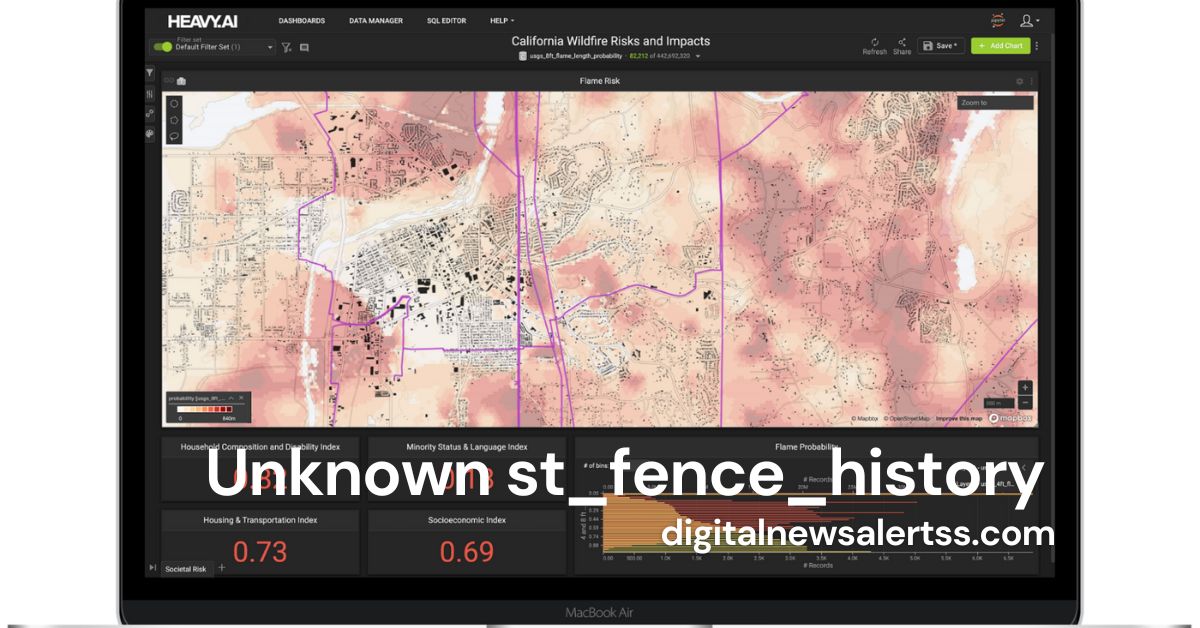Have you ever come across the term “unknown st_fence_history” and wondered what it means? You’re not alone. This mysterious phrase has puzzled many, especially those working with databases or geographic information systems. In this article, we’ll dive deep into the world of “unknown st_fence_history,” exploring its origins, significance, and potential applications. By the end, you’ll have a clear understanding of this intriguing concept and how it might apply to your work or interests.
What is “unknown st_fence_history”?
Before we unravel the mystery, let’s break down the term:
- “unknown”: This suggests something not yet identified or understood.
- “st_”: In database contexts, this often stands for “spatial type” or “spatial-temporal.”
- “fence”: In geospatial terms, this could refer to a boundary or barrier.
- “history”: This implies a record of past events or changes over time.
Putting these pieces together, “unknown st_fence_history” likely refers to an unidentified or unclear record of spatial or temporal boundaries. This could be relevant in various fields, including:
- Geographic Information Systems (GIS)
- Urban planning
- Land management
- Environmental studies
- Database management
The Origins of “unknown st_fence_history”
While the exact origins of this term are not well-documented, we can make some educated guesses based on its components:
- Database Evolution: As databases grew more complex, the need to store and manage spatial data increased. This led to the development of spatial databases and related query languages.
- GIS Advancements: The rise of Geographic Information Systems created a demand for more sophisticated ways to handle geographic data, including boundaries and their changes over time.
- Land Management Challenges: With growing populations and changing land use patterns, tracking property boundaries and their history became increasingly important.
- Data Migration Issues: As organizations moved data between different systems or upgraded their databases, some historical information about spatial boundaries may have been lost or become unclear.
Why Does “unknown st_fence_history” Matter?
Understanding “unknown st_fence_history” can be crucial for several reasons:
- Data Integrity: Identifying and resolving unknown elements in a database helps maintain accurate and reliable information.
- Historical Analysis: Clear boundary histories allow for better understanding of land use changes, urban development, and environmental shifts over time.
- Legal Implications: In property disputes or land rights cases, having a clear history of boundaries can be legally significant.
- Urban Planning: Planners need accurate historical data to make informed decisions about future development.
- Environmental Management: Tracking changes in ecosystem boundaries over time is vital for conservation efforts and impact assessments.
Common Scenarios Where “unknown st_fence_history” Might Appear
Let’s explore some real-world situations where you might encounter this mysterious term:
- Database Migration: When moving data from an old system to a new one, some historical fence data might not transfer correctly, leading to “unknown” entries.
- Legacy Systems: Older databases might use outdated ways of storing spatial data, making it hard for modern systems to interpret the history of certain boundaries.
- Incomplete Records: In some cases, the original source of boundary information might be lost, leaving gaps in the historical record.
- Data Corruption: Technical issues could lead to the loss or corruption of spatial data, resulting in unknown histories.
- Merging Datasets: When combining data from different sources, inconsistencies in how fence histories are recorded could lead to unknown elements.
How to Address “unknown st_fence_history” Issues
If you’re facing challenges related to “unknown st_fence_history,” here are some steps you can take:
- Data Audit: Conduct a thorough review of your spatial database to identify all instances of unknown histories.
- Source Verification: Try to trace the original sources of your spatial data to fill in any gaps.
- Consult Historical Records: Look for old maps, surveys, or land records that might provide missing information.
- Use Advanced GIS Tools: Modern GIS software can help analyze and potentially reconstruct missing spatial histories.
- Collaborate with Experts: Work with geospatial specialists or database administrators who have experience dealing with similar issues.
- Implement Better Tracking: Set up systems to ensure future spatial data changes are properly recorded and maintained.
The Future of Spatial Data Management
As technology advances, we’re likely to see improvements in how spatial data, including fence histories, is managed:
- Blockchain for Land Records: Some experts propose using blockchain technology to create tamper-proof, transparent records of land boundaries and their changes over time.
- AI-Powered Analysis: Artificial intelligence could help identify patterns and fill gaps in spatial data histories.
- 3D Mapping: As 3D mapping becomes more common, we may see more comprehensive ways of recording and visualizing boundary changes over time.
- Standardization Efforts: There are ongoing efforts to create global standards for spatial data management, which could help reduce instances of unknown histories.
- Real-Time Updates: With the Internet of Things (IoT) and advanced sensors, we might soon have systems that update spatial data in real-time, creating more accurate and complete histories.
Case Studies: Resolving “unknown st_fence_history”
Let’s look at some hypothetical examples of how organizations have dealt with this issue:
- City of Newtown: When upgrading their GIS system, Newtown discovered numerous instances of “unknown st_fence_history.” They hired a team of historical geographers to research old city records and successfully filled in most of the gaps.
- GreenSpace Conservation Group: This environmental organization found unknown histories in their wetland boundary data. By combining satellite imagery analysis with field surveys, they reconstructed a more complete picture of how the wetlands had changed over time.
- Midwest Farming Cooperative: When merging data from several smaller farms, the cooperative encountered many unknown fence histories. They worked with local community elders and long-time residents to piece together the historical land divisions.
Conclusion
While “unknown st_fence_history” might seem like a daunting technical challenge, it represents an opportunity to dive deep into the rich tapestry of our spatial past. By understanding and addressing these unknown elements, we can build more accurate, useful, and insightful spatial databases. Whether you’re a GIS professional, urban planner, or simply someone curious about the world around you, the story behind our changing landscapes is one worth exploring.
As we continue to develop new technologies and standards for managing spatial data, the mysteries of “unknown st_fence_history” may become a thing of the past. Until then, it remains an intriguing puzzle that invites us to look more closely at the boundaries that shape our world.
FAQs About “unknown st_fence_history”
What does “st_” mean in database terms?
In database contexts, “st_” often stands for “spatial type” or “spatial-temporal,” indicating that the data relates to geographic locations or spatial relationships.
Can “unknown st_fence_history” affect property values?
Potentially, yes. Unclear boundary histories could lead to disputes or uncertainties about property lines, which might impact property values.
How common is the “unknown st_fence_history” issue?
While exact statistics are hard to come by, many organizations dealing with spatial data encounter this issue, especially when working with older or merged datasets.
Are there any legal implications of having “unknown st_fence_history” in land records?
Yes, there can be. Unclear boundary histories could complicate legal matters related to property rights, zoning, or land use disputes.
Can satellite imagery help resolve “unknown st_fence_history” issues?
Yes, historical satellite imagery can be a valuable tool in reconstructing past boundary changes and filling in gaps in spatial data history.
How does “unknown st_fence_history” relate to climate change research?
Climate researchers often need to track changes in ecosystems, coastlines, and land use over time. Unknown boundary histories can create challenges in accurately assessing these changes.
Are there any open-source tools available for dealing with “unknown st_fence_history”?
Yes, several open-source GIS tools, like QGIS and PostGIS, offer features that can help analyze and potentially reconstruct spatial data histories.
How might Indigenous knowledge help in resolving “unknown st_fence_history” issues?
Indigenous communities often have deep historical knowledge about land boundaries and usage. Consulting with Indigenous experts can provide valuable insights into unclear spatial histories.
Can machine learning help predict missing information in “unknown st_fence_history” cases?
Potentially, yes. Machine learning algorithms could analyze patterns in known spatial data to make educated guesses about unknown histories, although human verification would still be important.
How might future smart city initiatives address “unknown st_fence_history” challenges?
Smart city technologies, including IoT sensors and real-time data collection, could help create more comprehensive and accurate records of spatial changes, reducing future instances of unknown histories.



